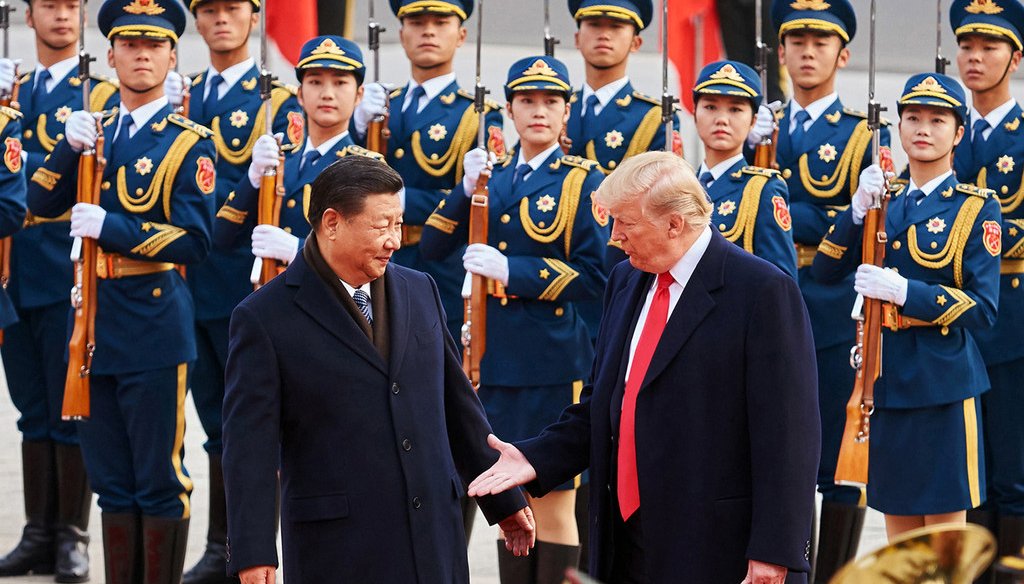

Our only agenda is to publish the truth so you can be an informed participant in democracy.
We need your help.


China's President Xi Jinping and U.S. President Donald Trump shake hands on Nov. 9, 2017, during a meeting in Beijing. The two are now at the center of a trade war with tariffs imposed on both sides. (Artyom Ivanov/Tass/Abaca Press/TNS)
With farmers across the nation whipsawed by falling commodity prices and rising tariffs, the industry needed some good news.
President Donald Trump’s administration announced in May that help was on the way for some in the form of a $16 billion farm aid package.
Farmers in particular have suffered from retaliatory tariffs amid an ongoing trade war with China. Trump imposed additional import taxes on Chinese goods in 2018, then raised many tariffs again — from 10% to 25% — in May 2019 after trade talks broke down. He unexpectedly announced another round of tariffs Aug. 1, 2019.
Along the way, China has responded by raising tariffs as well.
But it was the President’s repeated description of funding for that bailout that caught our eye.
"We are doing great with farmers now in a lot of ways. One way is we’re giving $16 billion out of all the tariffs we’re collecting," Trump told WTMJ-TV’s Charles Benson in a July 12, 2019, interview in Wisconsin. "Sixteen billion dollars all comes out of the tariffs that we’ve gotten from China."
Trump also referenced tariff payments "from China" when he announced the farm aid plan in May and many times since, including a July 30, 2019, news conference where he referred to "taking in billions and billions of dollars from China in the form of tariffs."
Is that really how tariffs work?
The short answer is no.
Here’s a description from the Urban Institute-Brookings Institution Tax Policy Center, an independent group that models the effects of tax legislation.
A tariff is a tax on imported goods. Despite what the President says, it is almost always paid directly by the importer (usually a domestic firm), and never by the exporting country. Thus, if the US imposes a tariff on Chinese televisions, the duty is paid to the US Customs and Border Protection Service at the border by a US broker representing a US importer, say, Costco. The Chinese government pays nothing, just as the US government pays no tax to Canada for that nation’s tariffs on imported dairy products. Rather, an importer or supplier for a Canadian supermarket pays the duty on Wisconsin cheese that lands in the grocer’s dairy counter.
That explanation, written in September 2018, noted that Trump has a "troubling lack of understanding about how the levies work."
The International Monetary Fund reported in May that this is indeed what happened, saying tariffs imposed on China have "been borne almost entirely by U.S. importers."
Those businesses, of course, often pass costs on to consumers. The Federal Reserve Bank of New York estimated in May that the round of tariffs imposed then on U.S. imports from China would cost the typical household $831 per year.
So China is not paying the tariffs. Then who’s paying for the farm aid?
The U.S. Department of Agriculture announced details of the bailout July 25, 2019, saying the first of three payments will likely be made by August.
The money is doled out for each county at a per-acre rate based on "the impact of unjustified trade retaliation in that county," ranging from $15 to $150 per acre. Aid is available to farmers who planted any of 27 non-specialty crops (including soybeans, corn, alfalfa hay, barley and wheat), as well as dairy and hog farmers and producers of certain fruit- and nut-bearing plants.
Aid per farmer is capped at $500,000. In addition to China, farmers can receive funding if they were harmed by U.S. trade conflicts with the European Union and Turkey.
This program is modeled after one implemented last year that distributed about $12 billion in aid to farmers.
The Associated Press reported the latest aid package includes $14.5 billion in direct aid in the aforementioned categories, and $1.4 billion to purchase surplus food from farmers and distribute them to schools and food banks.
That $16 billion is paid out through the Commodity Credit Corporation, a government institution supervised by USDA that can borrow up to $30 billion annually from the U.S. Treasury and distribute it to farmers without specific Congressional approval.
Secretary of Agriculture Sonny Perdue told the AP that China is "indirectly" paying for the aid, but he acknowledged tariffs are sent to the Treasury Department without being earmarked for any specific purpose.
Trump said $16 billion in farm aid is being funded "out of the tariffs that we’ve gotten from China."
Tariffs are paid into the U.S. Treasury, and the Treasury funds the farm aid. But there is no specific earmark or conduit connecting the two.
More significantly, Trump’s claim simply does not reflect how tariffs work.
The tariffs imposed by Trump have been paid almost entirely by U.S. importers, who pass much of that on to consumers through price increases.
We rate Trump’s claim False.
YouTube.com, Today’s TMJ4, Exclusive: Charles Benson chats one-on-one with President Trump, July 12, 2019
U.S. Department of Agriculture, USDA Announces Details of Support Package for Farmers, July 25, 2019
Associated Press, Trade impasse: Trump pledges $16B to farmers; markets slump, May 23, 2019
Email exchange with Dirk Fillpot, spokesman for the U.S. Department of Agriculture, July 31-Aug. 1, 2019
Tax Policy Center, Howard Gleckman, What Is A Tariff And Who Pays It?, Sept. 25, 2018
International Monetary Fund, The Impact of US-China Trade Tensions, May 23, 2019
Federal Reserve Bank of New York, New China Tariffs Increase Costs to U.S. Households, May 23, 2019
In a world of wild talk and fake news, help us stand up for the facts.
